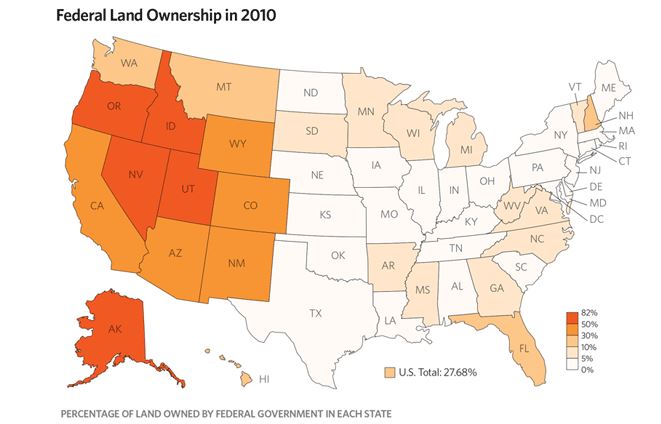This Washington-centric approach to management stifles creative, collaborative solutions to competing interests that could be resolved at local, state, or regional levels without the added baggage of national political battles and federal regulatory processes. While states and local communities may not always make perfect decisions, the best environmental policies are site-specific and situation-specific and emanate from liberty.
Excerpts from Daily Signal
Multi-Use, Federal Micromanagement of Local Choices, and Federal Inflexibility
Federal ownership and control results in a static approach to very dynamic energy markets. A recent oil and natural gas discovery in Colorado illustrates the problems and inflexibility due to federal management.
The U.S. Geological Survey (USGS) discovered this past June that Colorado has 40 times more technically recoverable natural gas resources than previously estimated. The discovery makes Colorado’s Mancos Shale in the Piceance Basin the second-largest known shale reserve in the country (after Pennsylvania), assessed by the USGS with over 66 trillion cubic feet of gas, 74 million barrels of shale oil, and 45 million barrels of natural gas liquids.[7] Prior to this most recent discovery, the USGS estimated that the area held only 1.6 trillion cubic feet of technically recoverable natural gas and provided no estimates for oil.[8] Yet these vast resources are not reflected in recent federal land-management plans for the region, which could be in effect for over a decade.
Though the economic potential for Colorado’s natural resources is great, federal bureaucracy stifles development by drastically curtailing where and how companies can access oil and gas resources in the Colorado Mancos Shale region. Much of the Mancos Shale falls under lands managed by the Forest Service (FS, under the Department of Agriculture), which collaborates with the Bureau of Land Management (BLM, under the Department of the Interior) to manage oil and gas resources. The Forest Service defines the lands available and the conditions for oil and gas development (among other uses) in management plans. The BLM then conducts and administers leases. Such plans generally govern resource management between 15 years and 20 years.
In December 2015, the Forest Service finalized its resource management plan for new leases in the White River National Forest, one of several in the Mancos Shale region. The plan significantly restricts the land that is available for resource development. Of the 2.3 million acres, the Forest Service only makes 194,100 acres accessible for oil and gas extraction.[9] This is half the acreage that was available under the last plan finalized in 1993, and just over 8 percent of the total available acreage. Based on this plan, the BLM published a final environmental impact statement in August 2016, proposing to cancel 25 of the 65 already existing leases on that land; the remaining leases will be modified to meet the Forest Service’s requirements for new leases.[10]
In the Forest Service’s final oil and gas plan in December, Forest Manager Scott Fitzwilliams wrote, “If new information or technological advances show the need to revisit this decision, I have the authority to do so. But at this time, I have decided to take a more conservation-minded approach to future gas leasing on the White River National Forest.”[11] Since then, the USGS has announced its discovery of 40 times more technically recoverable natural gas than previously estimated. Taking that second look is exactly what some Members in Congress are asking the BLM to do for existing leases there.[12] The same should be done elsewhere. There are 69 trillion cubic feet of proved natural gas resources on federal (onshore) lands, and there are 5.3 billion barrels of proved oil resources on federal (onshore) lands.[13] Yet the Obama Administration has directly (as in the case of the White River National Forest) and indirectly (via lease auction, moratoriums, and permit delays) restricted access to these resources.[14]
Because land owned by the federal government is abundant and diverse, grazers, farmers, tourists, hunters, and other individuals and groups have an interest in how the federal agencies manage the White River National Forest and other federal lands like it. For that reason, Congress passed multiple land-use laws to guide federal agencies. The Multiple Use and Sustained Yield Act, the National Forest Management Act for the Forest Service, and the Federal Land Policy and Management Act (FLPMA) for BLM are some of the principle guides for agencies on multiple land use. In practice, however, political agendas and bureaucratic priorities often cast interested parties to the side, limiting (in some instances prohibiting) certain economic activity, such as energy development.
For example, the parameters established in the FLPMA of multi-use, sustained yield, and environmental protection guide the BLM’s approach to land management.[15] Though these parameters may sound accommodating to all interested parties, each entails value choices which communities might prioritize and define differently than the federal government. The federal government is not in a good position, nor should it be the role of the federal government, to discern how these parameters ought to be applied on the ground and in a variety of communities.
Colorado is just one of many examples of the federal government’s ill-fitting management. The Forest Service’s White River resource management plan is a static approach to an otherwise dynamic environment and industry, as the USGS discovery months later showed. It offers a misguided notion of environmental stewardship, presuming that no management is good management and “keeping it in the ground” is the best way to protect the environment. Rather than accommodating multiple uses, the primary vision guiding the decision—what Fitzwilliams and the Forest Service called “environmentally preferable”—was one allowing “no new leasing.”[16]Management alternatives seem to have been measured according to how closely they aligned with this standard of “no use” rather than a standard of multi-land use.
Hardly an isolated problem, this particular debate over multi -land use in this area of Colorado has been brewing at least since 2010 when the Forest Service first began publically reviewing the White Forest management plan.[17] A particularly controversial area is the Thompson Divide, where other interest groups have protested against further oil and gas leasing, though wells have been operating there since 1947.[18] Executive director of the Thompson Divide Coalition, Zane Kessler, says that “this is about local control and a community’s desire to determine its own future” rather than outright opposition to the oil and gas industry.[19] But federal management of the land neither meaningfully fosters local and state control nor encourages more creative solutions at the local level between apparently competing uses for the land. Instead, Senator Michael Bennet (D–CO) has taken up the issue by introducing the Thompson Divide Withdrawal and Protection Act to prohibit oil and gas resource development.
Similar debates have surfaced in other issues too, such as the Department of the Interior’s regulatory scheme for greater-sage-grouse habitat. In this instance, the Department of the Interior did not seek meaningful or timely participation from local commissioners in nearby Garfield County, despite the extensive local efforts to restore habitat and grouse populations while also accommodating multi-use purposes.[20] It appears that national environmental groups that agreed with the Interior’s approach did receive greater access to federal decision makers, however.
These examples illustrate the larger systemic problem of federal land management and its multi-use land strategy. Local land-use issues, and undoubtedly highly contentious ones, should not need to wait for the U.S. Congress or a federal agency to weigh multiple land-use choices. Federalizing land management instantly politicizes decisions on a national level. Colorado has nine Representatives and Senators, and yet 526 other Congressmen and the Interior have a say in how federal land is used there. Unsurprisingly, larger political battles muddy local issues and concerns. Too often, Congress forces decisions through “must pass” legislation, such as omnibus spending bills, rather than considering land issues on their own merits.[21] In other instances, a President can unilaterally designate as land a national monument without say from Members or states, adding additional land-use restrictions in the process.[22]
This Washington-centric approach to management stifles creative, collaborative solutions to competing interests that could be resolved at local, state, or regional levels without the added baggage of national political battles and federal regulatory processes. While states and local communities may not always make perfect decisions, the best environmental policies are site-specific and situation-specific and emanate from liberty.[23]
State Governance Yields Better Economic and Environmental Results
Americans are fortunate that much of the shale oil and shale gas deposits in the U.S. are beneath state and privately owned lands. However, an important reason for its rapid increase in production has been an efficient permitting process. The time frame by which states process an application for a permit to drill is measured in days or weeks. The state average is 30 days and several states process applications in a fraction of that time.[24] Ohio requires a permit to be processed within 21 days, and an expedited permit within seven days.[25] Other states have similarly short time frames: Texas’s average is four days (expedited permits are two days),[26]and even in California, a permit must be processed within 10 days; if it is not, it is automatically approved.[27]
Efficiency pays off: Rather than spending undue time and money filling out and filing permit applications, companies are getting more—and more affordable—energy to the market. In October 2008, the United States produced 4.7 million barrels per day; production skyrocketed to more than 8.7 million barrels per day in October 2014.[28] According to the latest data from the U.S. Energy Information Administration, marketed natural gas production is at an all-time high in the U.S.[29]
The dramatic increase in oil and natural gas production drives down prices, putting money back into Americans’ bank accounts, and enabling American businesses to be more competitive. Lower gas prices have provided a huge windfall and are putting money back into the wallets of American households. Cheaper gasoline saved families approximately $700 in 2015.[30] The huge boost in disposable income gives them the opportunity to spend money going out to eat, on electronics, or at department stores. While some economists have warned of the dangers of low oil prices to financial markets, a new analysis from Merrill Lynch estimates that consistently low oil prices “will push back $3 trillion a year from oil producers to global consumers, setting the stage for one of the largest transfers of wealth in human history.”[31]
State control and local governance will also result in more accountable, effective management. While the federal government can simply pass on the costs of poor or no management to federal taxpayers, states have powerful incentives for better management of resources on federal lands. State governments and budgets can be more accountable to the people who will directly benefit from wise management decisions or be marginalized by poor ones, making it more likely that resources will be both developed—and developed in a way that protects the environment.[32]
States also have unique expertise in the lands within their bounds, unlike federal policies, which do not always make sense across the diversity of the federal estate. The geologic makeup of lands across the U.S. presents different economic and environmental challenges. State environmental regulators who already have the local expertise are more capable of providing efficient and timely guidance. Allowing state programs to function in place of federal ones employs this knowledge and relieves federal budgets of the burden to manage permitting requests and regulatory responsibilities, freeing up federal resources for more pressing issues, such as wildfire management.
On the other hand, federal management has devolved into unclear, redundant, and expensive regulations that often thwart good stewardship and enable discouragingly excessive litigation.[33]Furthermore, the federal government has proved to be inflexible in managing land, unresponsive to local concerns, and not competitively managed. While by no means perfect, state management of public lands has proved much more successful. Furthermore, the benefits extend well beyond mineral development. According to a recent Property and Environment Research Council report, “On average, states generate more revenue per dollar spent than the federal government on a variety of land management activities, including timber, grazing, minerals, and recreation.”[34]
The BLM and Forest Service lands lost $4.38 per acre from 2009–2013, while trust lands in four western states earned $34.60 per acre.[35] In terms simply of recreation, states again do a better job of making a return on their investment. Idaho and Montana averaged $6.86 per dollar spent on recreation on state trust lands; in contrast, the BLM earned $0.20 and the FS $0.28 per dollar spent, resulting in a net loss.[36] Incentives to invest in and steward the environment are stronger when people have direct ownership and responsibility.
Conclusion
States share the cost of the maintenance of federal lands, whether by the liability of no management, the lost opportunity of poor management, or the infrastructure needed to support development of resources. States have a proven record of managing resources, and already have the regulatory structures in place to do so on federal lands within their boundaries as well. Not only would new management multiply benefits for all Americans, it would also encourage better care of the environment and natural resources by putting them in the hands of people who have an immediate stake in wise management.
The Heritage Foundation is the most broadly supported think tank in the United States. During 2014, it had hundreds of thousands of individual, foundation, and corporate supporters representing every state in the U.S. Its 2014 income came from the following sources:
Individuals 75%
Foundations 12%
Corporations 3%
Program revenue and other income 10%
The top five corporate givers provided The Heritage Foundation with 2% of its 2014 income. The Heritage Foundation’s books are audited annually by the national accounting firm of RSM US, LLP.
Members of The Heritage Foundation staff testify as individuals discussing their own independent research. The views expressed are their own and do not reflect an institutional position for The Heritage Foundation or its board of trustees.
Nicholas Loris




The BLM is a massive waste of federal dollars We The People don’t have. Let the State’s and The People have their land back. We need to cut loose this bahemuth of bloated revenue wasting oversight! Get rid if the BLM.